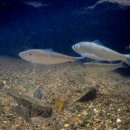In the 1920s, a dam was constructed within Westecunk Creek in Eagleswood Township along Silver Lake Road to impound water for local cranberry bog development. The barrier hindered the passage of year-round resident and migratory diadromous fish (those that move between fresh and salt water at different points in their life) during low flow conditions. With funding from Hurricane Sandy recovery (Disaster Relief Appropriations Act – H.R. 152), the structure was removed.
The 23-foot-long barrier was a concrete spillway that impeded natural hydrology in low water situations. Additionally, it was an attractive nuisance and unsafe. The completed project allowed for tidal flow to occur in 13km upstream of the structure once again. Species that benefitted from the restoration of the site included federal trust species such as alewife (Alosa pseudoharengus), blueback herring (Alosa aestivalis), and American eel (Anguilla rostrata). Adjacent upland areas were restored with native vegetation.
All vegetation was removed to clear the site and allow access for large equipment. The concrete walls were demolished and used onsite to fill a sluice channel. Fill material was used to cover the entire site, and vegetation such as Atlantic white-cedar (Chamaecyparis thyoides), Eastern red cedar (Juniperus virginiana), and forbs was planted. Construction started in December 2015 and was completed in April 2016 when the final plantings occurred. Monitoring of fish passage fish passage
Fish passage is the ability of fish or other aquatic species to move freely throughout their life to find food, reproduce, and complete their natural migration cycles. Millions of barriers to fish passage across the country are fragmenting habitat and leading to species declines. The U.S. Fish and Wildlife Service's National Fish Passage Program is working to reconnect watersheds to benefit both wildlife and people.
Learn more about fish passage occurred through a cooperative agreement with the Barnegat Bay Partnership. Some fish use was recorded immediately.
Project Budget:
Item | Funding Source | Amount |
|---|---|---|
Staff Time | Hurricane Sandy Resilience | $152,639 |
| Contract for project | Hurricane Sandy Resilience | $245,000 |
| Total | $397,639 |



